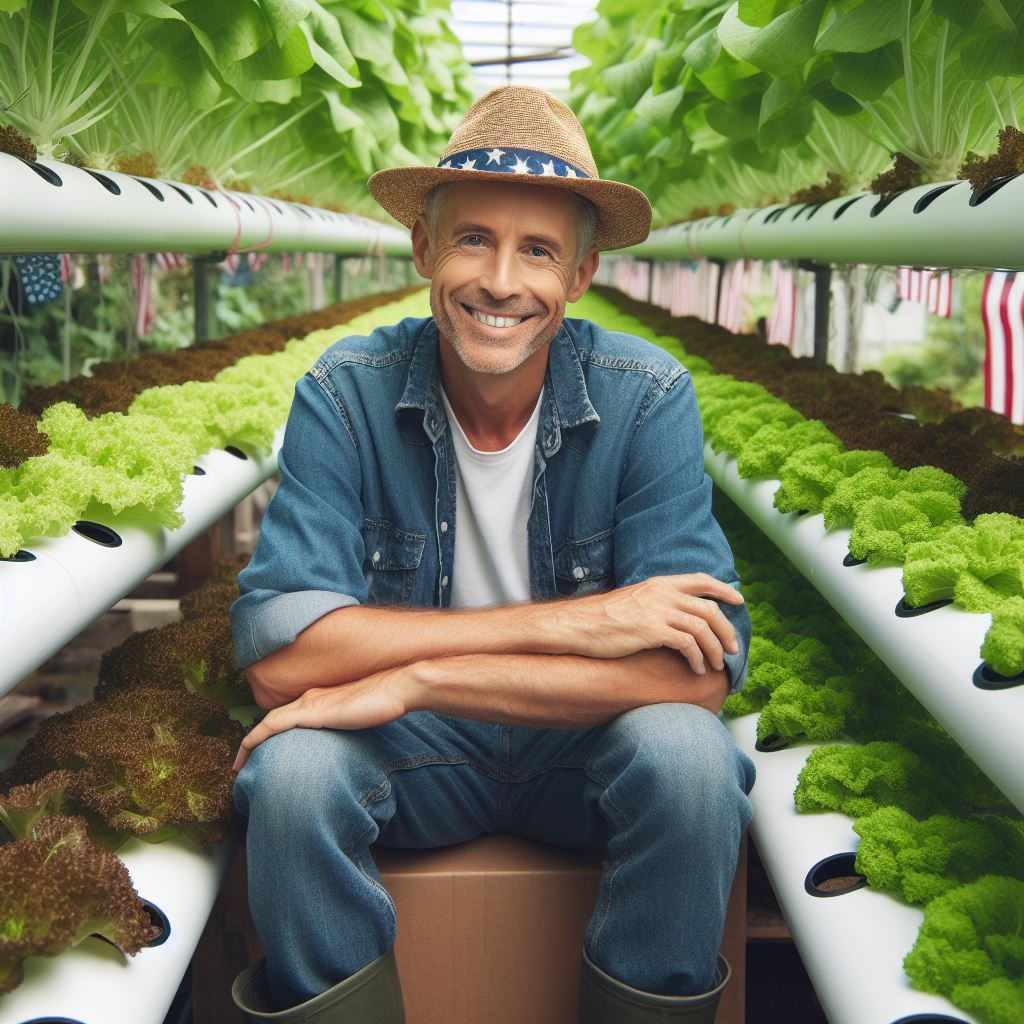Hydroponics: Gardening Without Soil
Last Updated on February 3, 2024
Introduction
Gardening without soil may sound like science fiction, but hydroponic systems that grow plants in nutrient solutions are rapidly growing in popularity.
Rather than planting crops in the earth, hydroponics utilizes advanced techniques to deliver nutrients directly to a plant’s roots.
This innovative method is gaining devotees around the globe as both large-scale farmers and urban gardeners discover its potential benefits.
Welcome to the fascinating world of hydroponics! In this blog, I aim to provide an accessible overview of soilless gardening for those seeking an introduction.
We will explore the history of hydroponics and examine key techniques like NFT channels, aeroponics towers, deep water systems, and aggregate containers.
You’ll learn basics about formula mixing and maintaining stable conditions.
We’ll compare the costs and yields of hydro vs soil.
And we’ll spotlight creative system builders pushing boundaries.
Whether you live on a hundred acres or in a studio apartment with just a sunny windowsill, innovations in hydroponic technology may open new possibilities for your green thumb ambitions!
What is Hydroponics?
Hydroponics as a method of growing plants without using soil
Hydroponics is a technique that allows plants to grow without soil, using a nutrient-rich water solution instead.
The primary components of a hydroponic system
In a hydroponic system, plants are grown in water that contains the necessary nutrients for their growth.
The water is often enriched with minerals and oxygen.
A growing medium, such as perlite or coconut coir, provides support for the plants’ roots.
Benefits of hydroponics
Hydroponics offers several advantages over traditional soil-based gardening.
Firstly, it is a much more water-efficient technique as it uses only a fraction of the water required in traditional gardening.
This is because water in a hydroponic system is recirculated and reused, minimizing wastage.
Secondly, hydroponic plants tend to grow faster than their soil-grown counterparts.
This is because the plants have direct access to all the nutrients they need, resulting in stronger and healthier growth.
Additionally, hydroponics allows for year-round gardening, irrespective of the external climate.
This is achieved by controlling the temperature, humidity, and lighting conditions in the growing environment.
Common misconceptions about hydroponics
- Hydroponics is not the same as aquaponics. While both techniques involve soil-less growing, aquaponics combines hydroponics with aquaculture, where fish or other aquatic organisms provide the necessary nutrients for the plants.
- Hydroponics does require the use of fertilizers, but in a controlled manner. The nutrient solution used in hydroponics contains a balanced mixture of essential elements that plants need for growth.
- Some people believe that hydroponics produces tasteless fruits and vegetables. However, studies have shown that hydroponically grown produce can be just as flavorful and nutritious as conventionally grown crops, if not better. In fact, hydroponics can even enhance the flavors of certain fruits and vegetables.
- Another common misconception is that hydroponics is expensive. While the initial setup cost may be higher compared to traditional gardening, the long-term benefits, such as water savings and higher crop yields, often make it a cost-effective choice in the long run.
Generally, hydroponics is a method of growing plants without the use of soil, relying instead on nutrient-rich water solutions.
It offers numerous benefits, including water efficiency, faster growth, and the ability to garden year-round.
By dispelling common misconceptions, such as tasteless produce and high costs, more people can appreciate and explore the potential of hydroponics in modern gardening.
Read: Apartment Aquaponics: Fish & Plants
Types of Hydroponic Systems
Overview of various hydroponic systems
- Deep water culture (DWC)
- Nutrient film technique (NFT)
- Drip system
- Ebb and flow system
- Aeroponics
The functioning of each system, including key components and their advantages
Hydroponics is a game-changing gardening method that allows plants to grow without the use of soil.
Instead of relying on traditional soil-based cultivation, hydroponics relies on nutrient-rich water solutions to provide plants with all the essential elements for their growth and development.
This innovative approach not only eliminates the need for soil but also conserves water and offers higher yields compared to traditional farming methods.
One of the key aspects of hydroponics is the variety of systems available for growers to choose from.
Each system has its unique characteristics and advantages, allowing gardeners to select the most suitable method based on their preferences and the types of plants they wish to grow.
Deep water culture (DWC)
This system involves suspending plant roots directly into a nutrient-rich water solution.
The plant roots are provided with oxygen through air pumps, promoting rapid growth.
The main advantage of DWC is its simplicity and low-cost setup, making it an ideal choice for beginners.
Nutrient film technique (NFT)
In the NFT system, a thin film of nutrient solution continuously flows over the plant roots, which are suspended in a sloping channel.
This provides constant access to water and nutrients while also allowing oxygen to reach the roots.
The NFT system is known for its efficient use of water and nutrients, making it suitable for larger-scale commercial operations.
Drip system
The drip system utilizes a drip emitter to supply a controlled amount of nutrient solution to the plant’s root zone.
This slow and precise delivery prevents wastage and allows for easy adjustments of nutrient concentrations.
The drip system is versatile, suitable for a variety of plants, and can be automated for convenience.
Ebb and flow system
Also known as a flood and drain system, the ebb and flow system periodically floods the plant’s root zone with the nutrient solution and then drains it back into a reservoir.
This cyclic process ensures that roots receive necessary water and nutrients while avoiding waterlogging.
The ebb and flow system is versatile, suitable for various plant sizes, and enables easy customization.
Aeroponics
Aeroponics is considered the most advanced and efficient hydroponic system.
It involves misting plant roots with a nutrient-rich solution, providing them with oxygen and vital nutrients.
The roots are suspended in air, promoting faster growth and higher yields.
Aeroponics allows for precise control over nutrient delivery and conserves water significantly.
Unique advantages offered by each of the hydroponic system
- DWC provides simplicity, low-cost, and suitable for beginners.
- NFT is efficient in water and nutrient use, making it ideal for commercial-scale operations.
- Drip system allows for precise control and is versatile for various plant types.
- Ebb and flow system offers customization options and accommodates different plant sizes.
- Aeroponics is the most efficient with water usage and promotes rapid growth.
Essentially, hydroponics offers a range of systems for gardeners to choose from, each with its own set of advantages.
Whether opting for the simplicity of deep water culture or the advanced techniques of aeroponics, hydroponics presents an innovative and sustainable solution for gardening without the reliance on traditional soil-based methods.
Read: DIY Urban Greenhouse: Step-by-Step
Choosing and Setting Up a Hydroponic System
Factors to Consider When Selecting a System
- Available space for the system is an important factor to consider before making a purchase.
- Your budget plays a significant role in determining the type and size of the hydroponic system.
- Your experience level in gardening should determine the complexity of the hydroponic system you choose.
Important Components of a Hydroponic System
- Pumps are crucial as they help circulate the nutrient solution, providing necessary oxygen to the plants’ roots.
- Reservoirs hold the nutrient solution and ensure a constant supply to the plants.
- pH monitoring tools help maintain the correct pH level in the nutrient solution for optimal plant growth.
Step-by-Step Instructions on Setting Up a Basic Hydroponic System for Beginners
- Choose a suitable location for your hydroponic system, ensuring it has proper access to light and ventilation.
- Select a container or tray to act as a reservoir for the nutrient solution.
- Place the pump in the reservoir and connect it to the appropriate tubing.
- Attach the tubing to the outlet of the pump, which will deliver the nutrient solution to the plants.
- Position the plants in net pots or a grow tray, allowing their roots to be suspended in the nutrient solution.
- Fill the reservoir with the appropriate amount of nutrient solution, following the instructions provided.
- Ensure the pH level of the nutrient solution is within the optimal range for the plants you’re growing.
- Monitor the system regularly, checking the nutrient solution levels and pH, and make any necessary adjustments.
- Provide adequate lighting and ventilation to support the plants’ growth and maintain a suitable temperature.
- Regularly clean and maintain the system, removing any algae or debris that may accumulate over time.
Setting up a hydroponic system may seem overwhelming at first, but with proper planning and understanding of the components involved, it can be a rewarding experience.
Consider factors such as space availability, budget, and your gardening experience level when choosing a system.
The important components of a hydroponic system, including pumps, reservoirs, and pH monitoring tools, ensure the proper functioning and growth of your plants.
Follow the step-by-step instructions for setting up a basic hydroponic system, and remember to monitor and maintain the system regularly.
With time and practice, you’ll become more comfortable with hydroponics and can even expand your setup to grow a variety of plants.
Read: Urban Chicken Coops: Fresh Eggs Daily

Nutrient Solutions for Hydroponics
Importance of Nutrient Solutions in Hydroponic Gardening
Nutrient solutions play a crucial role in hydroponic gardening by providing plants with their required elements for growth and development.
Instead of soil, hydroponic systems rely on these solutions to nourish plants.
Essential Nutrients for Plants and Their Roles in Growth and Development
Plants need several essential nutrients to thrive in hydroponics.
Each nutrient has a specific role in their growth and development. These include:
- Nitrogen: Responsible for foliage development and overall plant vigor.
- Phosphorus: Facilitates strong root growth, flowering, and fruit production.
- Potassium: Enhances disease resistance, overall plant strength, and quality of fruits.
- Calcium: Builds cell walls and promotes nutrient absorption.
- Magnesium: A crucial component of chlorophyll, essential for photosynthesis.
- Iron: Essential for chlorophyll synthesis and enzyme function.
- Manganese, zinc, copper: Micronutrients that are required in smaller quantities but are crucial for plant metabolism.
Ensuring each nutrient is provided adequately is vital for optimum plant health.
Different Commercially Available Nutrient Solutions and Their Variations
Several companies offer nutrient solutions specifically formulated for hydroponic systems.
These solutions come in different variations to meet the diverse needs of plants.
Some popular nutrient solution brands include General Hydroponics, Advanced Nutrients, and Fox Farm.
Different formulations cater to various plant growth stages, such as vegetative, flowering, and fruiting.
This flexibility allows gardeners to choose the most appropriate solution based on their crops and growth goals.
Importance of Maintaining Proper pH Levels in the Nutrient Solution
Maintaining the correct pH level in the nutrient solution is crucial for plant growth.
Hydroponic plants thrive within a specific pH range, usually between 5.5 and 6.5.
If the pH level deviates, nutrient uptake becomes inefficient, leading to deficiencies or toxicities.
The pH can be adjusted using pH-balancing products like pH up or pH down.
Regularly monitoring and adjusting the pH ensures that plants can absorb nutrients optimally, promoting healthy growth and preventing potential problems.
Essentially, nutrient solutions are vital components of hydroponic gardening as they provide plants with essential elements needed for growth and development.
Understanding the roles of each nutrient, exploring various commercially available solutions, and maintaining proper pH levels are key to successful hydroponic gardening.
By managing nutrient solutions effectively, gardeners can achieve thriving plants and maximize their hydroponic yields.
Read: Window Box Farming: Herbs and Flowers
Common Plants that Thrive in Hydroponics
List popular plants that grow well in hydroponic systems
- Lettuce: Varieties like Buttercrunch, Romaine, and Bibb are perfect for hydroponics.
- Herbs: Basil, mint, sage, and parsley are some popular herbs that flourish in hydroponic setups.
- Tomatoes: Cherry tomatoes, beefsteak tomatoes, and Roma tomatoes thrive in hydroponic systems.
- Strawberries: These juicy fruits can be grown successfully in hydroponics, providing a delicious yield.
- Cucumbers: Varieties such as English cucumbers and pickling cucumbers grow exceptionally well in hydroponics.
Tips and recommendations for growing herbs, lettuce, tomatoes, and other common plants
- Choose the right system: Deep water culture or nutrient film technique works best for lettuce and herbs.
- Use quality seeds or seedlings: Start with healthy plants to ensure strong growth in hydroponics.
- Maintain proper pH levels: Lettuce and herbs prefer a pH range of 5.5 to 6.5, while tomatoes thrive at 6.0 to 6.5.
- Provide adequate lighting: Full-spectrum LED lights or high-pressure sodium lights are ideal for indoor hydroponic gardens.
- Monitor nutrient levels: Regularly check and adjust nutrient solutions to provide the required elements for optimal plant growth.
Potential challenges and how to address them for specific plant species
- Nutrient deficiencies: Monitor plant leaves for any signs of yellowing or discoloration and adjust nutrient solutions accordingly.
- Disease and pests: Maintain good hygiene, use organic pesticides if necessary, and keep a vigilant eye on your plants.
- Temperature control: Keep the temperature within the recommended range for each plant species to avoid stunted growth or wilting.
- Water quality: Ensure the water used in the hydroponic system is free from contaminants or excessive mineral content.
- Root rot: Avoid overwatering and ensure proper oxygenation to prevent root rot, especially in lettuce and herbs.
In general, hydroponics offers a fantastic way to grow a wide range of plants, including lettuce, herbs, tomatoes, strawberries, and cucumbers.
By following the tips provided, any aspiring hydroponic gardener can expect successful yields.
Remember to address potential challenges promptly, and with proper care, your hydroponic garden will thrive with vibrant and healthy plants.
Troubleshooting and Maintenance
Common issues and challenges faced in hydroponics, such as nutrient deficiencies, pH imbalance, or pests
- Nutrient deficiencies can occur in hydroponics if the nutrient solution is not properly balanced.
- pH imbalance can lead to nutrient lockout, affecting the plants’ ability to absorb essential nutrients.
- Pests like aphids, whiteflies, or spider mites can infest hydroponic systems, damaging the plants.
Troubleshooting tips and solutions for maintaining a healthy hydroponic system
- To address nutrient deficiencies, regularly monitor the nutrient solution’s composition and adjust it accordingly.
- For pH imbalance, test the pH levels regularly and use pH adjusters to keep it within the optimal range.
- Control pests by implementing integrated pest management techniques, such as introducing beneficial insects or using organic insecticides.
Importance of regular maintenance tasks like cleaning, sterilizing, and monitoring system components
- Regular cleaning prevents the buildup of algae, debris, and pathogens in the system, ensuring optimum plant health.
- Sterilizing components like grow trays or water reservoirs helps eliminate harmful bacteria, fungi, and viruses.
- Monitoring system components allows early detection of any malfunctions or issues, preventing larger problems in the future.
Maintaining a hydroponic system can sometimes be challenging, but with proper troubleshooting and regular maintenance, these challenges can be overcome.
Addressing Nutrient Deficiencies
One common issue in hydroponics is nutrient deficiencies, which can occur if the nutrient solution is not properly balanced.
It is crucial to regularly monitor the composition of the nutrient solution and adjust it based on the plants’ needs.
Various symptoms can indicate specific nutrient deficiencies.
For example, yellowing leaves may indicate a lack of nitrogen, while purple or red stems may signal a phosphorus deficiency.
Identifying these symptoms can help hydroponic gardeners take appropriate action to rectify the issue.
Dealing with pH Imbalance
Maintaining the pH balance in a hydroponic system is vital for optimal nutrient uptake by the plants.
pH imbalance can lead to nutrient lockout, where essential nutrients become unavailable to the plants.
Regularly testing the pH levels of the nutrient solution using pH testing kits or meters is crucial.
If the pH is off, pH adjusters like pH up or pH down solutions can be used to bring it back within the optimal range for the specific plants being grown.
Controlling Pests in Hydroponics
Pests can pose a significant threat to hydroponic systems.
Aphids, whiteflies, or spider mites are common pests that infest hydroponic gardens.
Implementing integrated pest management techniques is essential to control pests while minimizing harm to the plants and the environment.
This can include introducing beneficial insects like ladybugs or lacewings, using sticky traps, or applying organic insecticides specifically formulated for hydroponic systems.
Importance of Regular Maintenance Tasks
Regular maintenance tasks are crucial for the long-term success of a hydroponic system.
Performing cleaning routines, such as removing algae and debris from the grow trays, ensures optimal light penetration and prevents clogs in the system.
Sterilizing components like grow trays or water reservoirs helps eliminate harmful bacteria, fungi, and viruses that can weaken or damage the plants.
Additionally, monitoring system components, such as pumps, timers, and sensors, allows hydroponic gardeners to quickly identify any malfunctions or issues and address them promptly, preventing larger problems in the future.
In essence, troubleshooting and regular maintenance are integral to maintaining a healthy hydroponic system.
By addressing common issues like nutrient deficiencies and pH imbalance and implementing proper cleaning, sterilizing, and monitoring practices, hydroponic gardeners can overcome challenges and ensure the success of their gardens.
Conclusion
This blog post discussed the key points of hydroponics, a gardening method without soil.
It highlighted the benefits of hydroponics, such as increased yields, water efficiency, and the elimination of soil-borne diseases.
Furthermore, it emphasized the potential of hydroponics for the future in addressing food scarcity and promoting sustainable agriculture.
Readers are encouraged to explore hydroponics as an alternative and sustainable gardening option, contributing to a healthier and more environmentally friendly future.
By adopting hydroponics, individuals can grow their own fresh produce, regardless of limited outdoor space or poor soil quality.
It is important to note that hydroponics requires careful monitoring of nutrients and pH levels to ensure optimal plant growth.
However, with advancements in technology and an increasing interest in urban farming, hydroponics is becoming more accessible and efficient.
Moreover, hydroponics can reduce the reliance on chemical fertilizers and pesticides, leading to healthier and safer food products.
In a nutshell, hydroponics offers a practical solution to improve food production and sustainability, making it a gardening method worth exploring.


